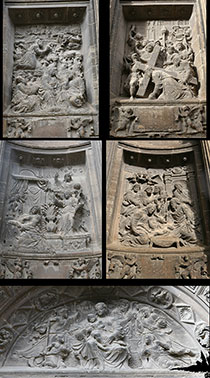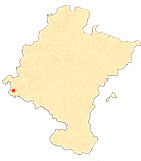Front façade of the parish church of Santa María de Viana
Infancy and Passion of Christ
On the sides of the door and placed in rectangular boxes on a base with cartouches of twisted bodies, there are four passages of the infancy and passion of Christ, complemented with a Holy Family in Sacred Converzacione in the tympanum of the entrance door. Thus, we find the Prayer in the Garden and the Fall on the way to Calvary on the exterior face, and the Annunciation and Nativity on the interior, framing in the tympanum the Virgin and Child and St. Joseph with St. John as a child. They are the best executed reliefs of all the sculptural group of the cover, due to their preeminent position in the same one, spit in a naturalistic way, with a careful execution, great fineness in the gestures and attention to the details. The Prayer in the Garden is resolved in two planes in height, separated by a line of trees. In the lower part are the apostles Peter, James and John, asleep, oblivious to what is happening in the upper part, where we see the figure of Christ kneeling in prayerful attitude in front of an angel who carries in his hands part of the Arma Christi: a cross and a chalice. The scene takes place in the Garden of Gethsemane, on the Mount of Olives, and reflects the moment in which Christ seeks consolation for his agony and accepts his destiny. The Annunciation follows, represented as usual inside Mary's chamber, when the archangel Gabriel appears to her announcing that she is pregnant with the Son of God. This is the moment of Christ's incarnation. The composition is resolved in a diagonal of ascending character, from the figure of the Virgin to that of God the Father, who acquires great prominence, with his resounding presence over Gabriel. Also noteworthy for its proportions is the jar of lilies, symbol of the virginity and purity of the Virgin, and the heraldic arms of the Vianese parish, which we see repeated in the pylons that mark the outer perimeter of the same. On the other side is Christ on the way to Calvary, in a composition in height, of great variegation, marked by the figure of Jesus kneeling defeated by the weight of the cross, which acts as a separation between his figure and that of the thugs and women, among whom Veronica can be distinguished at the top with the cloth in her hands. The Nativity also marks a double plane in height, in the lower part is Jesus in the manger and on the sides the Virgin and Saint Joseph in an attitude of adoration, and behind them a series of figures framed by a Renaissance architecture, following that of the doorway. Finally, in the tympanum of the door, and also in a double plane, is the Holy Family accompanied by St. John child and several adoring angels, a composition in which the resounding Issue of the Virgin stands out, as well as its delicacy.
-
ESTEBAN LORENTE, J.F., "El arco de ingreso de la colegiata de Santa María de Viana. Horóscopo de Cristo", Berceo, 130, 1996, pp. 177-178.
-
ESTEBAN LORENTE, J.F., "Los dioses paganos en las iglesias españolas del siglo XVI", bulletin del Museo e high school Camón Aznar, LXXXII, Zaragoza, high school Camón Aznar, 2000, pp. 157-190.
-
FERNÁNDEZ GRACIA, R., (coord.), ECHEVERRIA GOÑI, P.L., and GARCÍA GAINZA, M. C., El arte del Renacimiento en Navarra, Pamplona, Gobierno de Navarra, 2005, pp. 111-114.
-
GARCÍA GAINZA, M. C., HEREDIA MORENO, M. C., RIVAS CARMONA, J. and ORBE SIVATTE, M., Catalog Monumental de Navarra. V. II**. Merindad de Estella, Pamplona, 1980, pp. 559-564.
-
GONZÁLEZ DE ZÁRATE, J. M., "Aproximaciones a la lectura iconográfica del programa mitológico en la portada de Santa María de Viana", Primer congress General de Historia de Navarra, anejo 11, Pamplona, Príncipe de Viana, 1988, pp. 179-196.
-
LABEAGA MENDIOLA, J.C., Viana monumental y artística, Pamplona, Príncipe de Viana, 1984, pp. 229-236.












